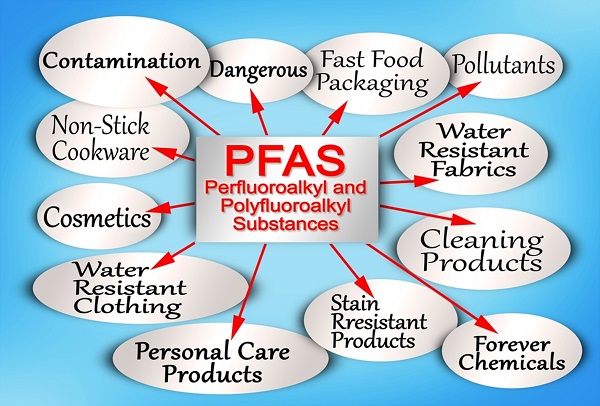
PFAS, an abbreviation for per- and polyfluoroalkyl substances, are a group of over 12,000 human-made chemicals that have been widely used since the 1940s in products like food packaging, stain-resistant fabrics, firefighting foam, and many industrial processes. They earned the nickname “forever chemicals” because they do not break down easily and can build up in the environment and human body over time.
PFAS are almost everywhere. Studies indicate that 97% of the U.S. population has PFAS in their system, which can cause a variety of health issues including liver damage, autoimmune disorders, reproductive system issues, and various cancers, according to the U.S. Agency for Toxic Substances and Disease Registry. While the risk of health effects associated with PFAS depends on the dose, frequency, route, and duration of a person’s exposure, mounting evidence shows that “workers might be exposed to PFAS in ways that the general public is not, such as by touching concentrated products or breathing PFAS in the air at their workplace,” according to the National Institute for Occupational Safety and Health (NIOSH).
NIOSH named several occupations that are exposed to PFAS more than the general U.S. population. Chemical manufacturing workers, firefighters, and ski wax technicians are among the most affected. However, the widespread use of products containing PFAS has increased concern among other industries, such as construction, where PFAS have been found in roofing materials, paints, wood sealers, metal coating, grout, and electrical wiring, among others.
While there is much scrutiny about the use of PFAS, currently, there are no federal workplace exposure limits. However, OSHA’s General Duty Clause requires employers to furnish their workers with “employment and a place of employment which are free from recognized hazards that are causing or are likely to cause death or serious physical harm.”
Reducing occupational PFAS exposures is critical for preventing adverse health effects. Until more guidelines are provided, the most effective ways to reduce PFAS exposure is by:
1 Elimination or substitution.
Replace PFAS-containing materials with safer alternatives whenever possible. This is the most effective way to eliminate PFAS exposure.
2 Engineering controls.
When the elimination of PFAS-containing materials is not feasible, engineering controls like proper ventilation systems, enclosures, and process modifications can help reduce airborne PFAS levels.
3 Administrative controls.
Establish administrative controls such as worker training programs, exposure monitoring, good housekeeping practices, and limiting access to contaminated areas. These measures can help minimize PFAS exposures.
4 Personal protective equipment (PPE).
Use PPE such as respirators and protective clothing when other controls cannot adequately reduce exposure levels.
5 Comply with OSHA’s Hazard Communication Standard.
OSHA's Hazard Communication Standard (29 CFR 1910.1200) requires employers to have an inventory of all chemicals in their workplace, and a Safety Data Sheet (SDS) for each one. SDSs outline the required PPE and exposure monitoring procedures for each chemical. Train employees on the hazards and control measures outlined in the SDSs.
While more research is needed to establish federal PFAS exposure limits, employers must take proactive measures to protect their employees from these harmful substances. If you would like free, onsite, or virtual assistance ensuring that your employees are protected from chemical exposure, such as PFAS, contact a DWC Occupational Safety and Health Consultant at OSHCON@tdi.texas.gov or 800-252-7031, option 2. For more information on the Texas Occupational Safety and Health Consultation (OSHCON) Program, visit www.txoshcon.com.
